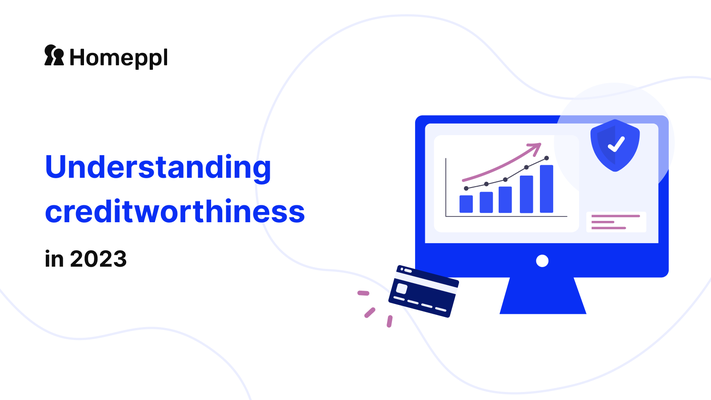What is Creditworthiness?
Creditworthiness is a measure of a consumer’s capacity and willingness to repay debt. You can hardly have reached your early 20s without prompts to check your credit score and subsequently, your qualification status for a credit card. The mark of early adulthood.
For businesses, credit and affordability assessments have always been integral to protecting both the lender and consumer. Credit checks, conducted by traditional Credit Reference Agencies (CRAs) such as Equifax, Experien and TransUnion, base their credit scoring system, that have traditionally determined creditworthiness for decades, on factors such as past handling of credit and debt, UK credit history, income, and assets.
I remember being shocked that my participation in the electoral register could even play havoc when it comes to the volatility of my creditworthiness. Traditional loan providers review credit reports from CRAs, check credit scores, verify income and debt, and document additional assets or resources and then, voila.. your score is determined. But, in 2023, the rise of automated risk underwriting technology and open banking algorithms have widened the data pool. Lenders now have the opportunity to determine a more precise assessment of risk and creditworthiness based on a number of non-credit related signals. When technology changes, regulations often do too. This article is a must read for the modern lender, looking for tips on how to truly assess consumer risk using data and modern technologies now available to them.

Regulatory concerns over traditional credit assessment checks
In 2021, The EU implemented new guidelines for creditworthiness assessment when approving loans following concerns regarding risk in the European consumer loan market following the COVID-19 pandemic. After the pandemic, households became more financially risky and as such riskier loans became more common. In the UK, it has been reported this week that 750,000 UK households are at risk of defaulting on their mortgage. These guidelines suggest that financial institutions should document borrowers' recurring income and expenses, as well as provide detailed explanations of how and why loans are approved. These guidelines are intended to improve the accuracy and reliability of the creditworthiness assessment process. However, it poses a significant challenge for traditional banks and lenders, as it requires them to identify and categorise customers' various sources of income and expenses, and to provide this information with a high level of granularity. In the past, this has increased the time and effort required to conduct accurate affordability assessments, ultimately making operations less efficient.
Although these are guidelines and not legislation, it gives a crystal clear indication of the direction in which the relationship between consumer data, risk, assessment and technology is heading in the EU, the UK and many countries around the world. This shift in regulatory advice commands an investment in new technology or systems on behalf of traditional lenders.
Technology-led, industry-led changes to affordability analysis
So how can new technologies provide this reliability in detail and granularity when assessing creditworthiness that have so far been missing from standard CRA checks?
By collecting and analysing a wider range of consumer data points
There are millions of consumers who seek access to credit, rental properties, or mortgages and other financial products who have either a ‘thin-filed’ credit history, an irregular pattern of income (the self-employed, high net worth individuals, investors, post graduate students) or no UK credit file at all (such as internationals).
CRAs don’t have the technology to conduct affordability checks much past checking for credit. This has created a pool of ‘invisivle’ consumers who are financially eligible for loans and credit but are rejected by standard credit assessments. These standard credit checking services have a high rejection rate, up to 30%, leaving millions without access to credit. A more precise assessment not only provides financial access, but also it ensures that those who already have access to credit can actually afford the financial products they are applying for without a considerable risk of default. Hence, the need for more data. And a fresher technology-driven lens with which to analyse that data.
Other data points that lend a helpful indication of a consumer’s creditworthiness include:
Transactional data
A review of a consumer’s bank transactions can provide unique insights into affordability. From using financial data enrichment tools to convert any bank statement into unified code, a host of more granular insights can be present as a risk report for each consumer.
Learn about:
income vs expenditure
specific spending categories
daily spending patterns
overdraft usage
suspicious payments
responsibility with money
debt repayments
and verify various income streams.
With the tech tools now available to fintechs, a bank statement is no longer just a laundry list of purchases.
Behavioural data
Informational data points surrounding employment history, company formation, digital footprint, residential history, property or rental information can also give a clear picture, alongside credit history of course, of what true creditworthiness looks like in 2023. When building or rethinking risk models, accuracy can now be guaranteed for lenders. Companies who utilise Homeppl’s financial qualification model on a daily basis have an average approval rate of around 95%, compared to the common 30% rejection rate of standard CRAs.
Business credit assessments and the rise of the Buy Now Pay Later product
When conducting business-to-business transactions, offering trade credit, or the ability for customers to purchase goods or services and pay at a later date, is a common practice that can help drive sales and support business growth. However, extending credit also exposes a business to the risk of late payment or default, which can negatively impact cash flow. To mitigate this risk, it is important to assess the creditworthiness of potential customers before extending credit.
One method for determining creditworthiness is by using the five Cs of credit: character, capacity, collateral, capital, and conditions. Character refers to the background and credentials of the trade partner, capacity refers to the business's cash flow situation, collateral refers to assets that can be liquidated to settle debt, capital refers to the business's financial stability, and conditions refer to external factors that may impact the business's ability to pay. By considering each of these factors, businesses can conduct a credit assessment to determine the likelihood of default and potential financial loss.
The UK Buy Now Pay Later market will be worth £26.8bn by 2024. The appeal of the BNPL journey for online consumers rests on how quick and simple the buying journey is. Considering that most purchases made via BNPL vendors such as Klarna are for items priced between £65-£85, customers are more likely to abandon the transaction should the credit check take too long. Low friction affordability checks are then vital to that market, which will most likely be serviced with Open Banking algorithms, the most secure and precise form of income verification.
A trend of digitalisation in affordability analysis
UK regulator, the Financial Conduct Authority (FCA) has recently stated that a new industry body is needed in the CRA sector to help improve the quality of consumer credit ratings. The FCA said that an industry committee known as SCOR, for lenders and raters to share credit information on consumers, is too narrow, with no representatives from consumers or "challenger" companies.
So we have the worries of EU regulators over the accuracy of traditional creditworthiness assessments in the European consumer loan market. We have the FCA in the UK concerned over the quality of consumer credit ratings amongst traditional CRAs. And, we have emerging lenders with a demand quick affordability checks to satisfy short-term consumer loans altering the standard risk profile.
It is clear that financial institutions should have the capability to determine various income sources of their customers while also identifying their regular expenses. Furthermore, they should be able to classify these expenses with a high degree of detail. Observing the market participants who have already implemented this, it is highly likely that the classification of regular expenses must be divided into broader categories like: costs related to housing, transportation, credit, and personal expenses.

This provides a better understanding for the lender with regards to true affordability and risk and protects the borrower, who may not be in a financial position to repay. Homeppl’s transactional data analysis and automated risk assessment technology adheres to these industry painpoint and regulatory concerns, protects both the consumer and lender with granular financial intelligence and enhances operational efficiency by alleviating a considerable degree of manual work. The trend towards digital adoption is growing ever stronger in 2023. Financiers who embrace this trend will strike a better balance between greater approvals and fewer defaults.
What to read next:
Financial data enrichment: What is it?
The rising threat of fraud in the insurance sector
Risk management for Fintechs: Build a strong framework in the consumer loans space



